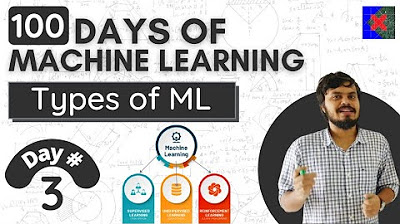Машинное обучение. Лекция 6. Кластеризация
Summary
TLDRThis video provides an introduction to clustering techniques in machine learning, explaining their importance and applications. It covers the basic concepts of clustering, where objects are grouped based on similarity without predefined labels. The script dives into popular clustering algorithms such as K-means, affinity propagation, and agglomerative clustering, discussing how each works and their respective advantages and limitations. The video also highlights real-world applications like user segmentation, anomaly detection, and text topic categorization. Finally, it addresses challenges in clustering, particularly the selection of the optimal number of clusters, and suggests practical approaches for solving these issues.
Takeaways
- 😀 Clustering is a process of grouping similar objects without predefined labels, focusing on unsupervised learning.
- 😀 It’s widely used in various fields such as user segmentation, anomaly detection, text categorization, and image segmentation.
- 😀 In user segmentation, clustering helps divide customers into groups for tailored services or discounts, such as in banks or mobile operators.
- 😀 Clustering aids in anomaly detection, like identifying unusual patterns in heart disease data using ECG readings.
- 😀 In text categorization, clustering is used to categorize news articles into topics like sports, politics, or culture without predefined labels.
- 😀 Image segmentation involves grouping pixels with similar characteristics to detect objects in photos, like cars or people.
- 😀 The K-means algorithm is one of the most popular clustering methods, which randomly initializes cluster centers and iteratively assigns objects to clusters.
- 😀 Affinity Propagation uses similarity measures between objects and iterates to adjust matrices, forming clusters with computational complexity as a consideration.
- 😀 Agglomerative Clustering starts with each object as its own cluster and merges them iteratively, creating a hierarchical structure (dendrogram).
- 😀 Choosing the right number of clusters is a common challenge in clustering algorithms, with some algorithms requiring it to be predefined, like K-means.
- 😀 Distance metrics (e.g., Euclidean, Minkowski) significantly affect the clustering results and must be chosen based on the dataset and context.
Q & A
What is clustering, and how is it different from supervised learning?
-Clustering is an unsupervised learning method used to group similar objects or data points together based on their characteristics. Unlike supervised learning, where we predict predefined labels, clustering involves finding inherent patterns in the data without having any prior knowledge of the labels.
What are some common applications of clustering?
-Clustering is widely used in various fields, including customer segmentation (grouping users based on behavior), anomaly detection (identifying outliers like heart defects from ECG data), and text classification (grouping news articles based on topics).
What is the main objective of clustering?
-The main objective of clustering is to partition a dataset into groups (clusters) such that objects within the same cluster are more similar to each other than to those in different clusters.
How does K-means clustering work?
-K-means clustering assigns data points to a specified number of clusters by randomly initializing cluster centroids, then iteratively updating these centroids based on the mean of the points assigned to each cluster. The process repeats until the centroids stabilize.
What is a major disadvantage of K-means clustering?
-A major disadvantage of K-means is that it requires the user to specify the number of clusters (k) in advance. Additionally, it is sensitive to the initial placement of centroids, which can lead to suboptimal clustering results.
How does Affinity Propagation differ from K-means clustering?
-Affinity Propagation does not require the user to specify the number of clusters upfront. Instead, it uses a similarity matrix to determine which data points best represent cluster centers, allowing it to detect the number of clusters automatically. However, it is more computationally expensive than K-means.
What is Agglomerative Clustering and how does it work?
-Agglomerative Clustering is a hierarchical method where each data point initially represents its own cluster. The algorithm repeatedly merges the closest clusters based on a chosen distance metric, forming a hierarchy of clusters. The process continues until only one cluster remains or the desired number of clusters is reached.
What is the key advantage of Agglomerative Clustering?
-One key advantage of Agglomerative Clustering is that it does not require the user to specify the number of clusters in advance, and it creates a hierarchical structure, which can be visualized as a dendrogram, showing the relationship between clusters at different levels of granularity.
Why is K-means often preferred in practice despite its limitations?
-K-means is often preferred because it is fast and works well for large datasets. It provides a good initial approximation of the clustering structure, allowing users to quickly analyze and understand the data, even though more advanced methods may yield better results.
How does the 'mini-batch K-means' algorithm improve upon the standard K-means algorithm?
-Mini-batch K-means improves upon standard K-means by updating cluster centroids using a smaller, randomly selected subset of the data at each iteration. This reduces computational costs and speeds up the algorithm, though it may be slightly less accurate than the full K-means method.
Outlines

This section is available to paid users only. Please upgrade to access this part.
Upgrade NowMindmap

This section is available to paid users only. Please upgrade to access this part.
Upgrade NowKeywords

This section is available to paid users only. Please upgrade to access this part.
Upgrade NowHighlights

This section is available to paid users only. Please upgrade to access this part.
Upgrade NowTranscripts

This section is available to paid users only. Please upgrade to access this part.
Upgrade NowBrowse More Related Video

TEKNIK CLUSTERING UNTUK MENGANALISA DATA MAHASISWA

O Que É Machine Learning?

Types of Machine Learning for Beginners | Types of Machine learning in Hindi | Types of ML in Depth

ML model categories

Introduction to ML: What is Machine Learning? | ML for Beginners

Week 1 - Lecture 1 - Introduction to Machine Learning
5.0 / 5 (0 votes)